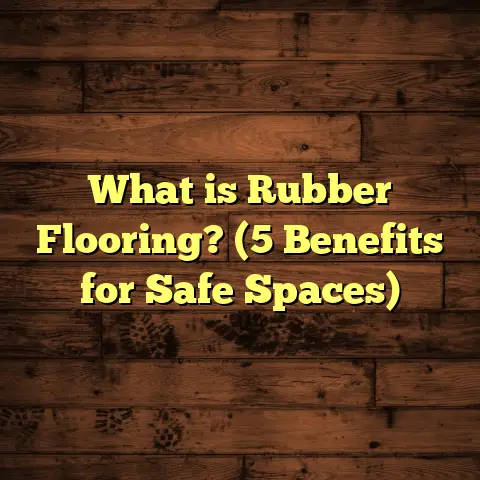What is Wear Layer on Lifeproof Flooring? (5 Key Benefits Unveiled)
Nostalgia has a way of sneaking up on me when I least expect it. I often find myself recalling the floors of my childhood home—the aged hardwood with its countless scratches, dents, and scuffs, each telling a story of moments lived and memories made. Those floors weren’t just surfaces; they were silent witnesses to laughter, tears, spills, and celebrations. It’s funny how something as ordinary as a floor can hold so much significance when you stop and think about it. That’s why when I got into installing Lifeproof flooring, I became fascinated by what keeps these floors looking fresh, durable, and beautiful over time, especially in busy households. One thing that stood out immediately was the “wear layer.” But what exactly is that? How does it work? And why should it matter to you?
I want to share everything I’ve learned over years of hands-on experience, research, and working with clients—all in a straightforward chat like we’re hanging out, talking floors over coffee.
What is Wear Layer on Lifeproof Flooring?
The term “wear layer” might sound technical, but it’s actually pretty simple once you get the hang of it. The wear layer is the clear protective coating that sits on top of Lifeproof flooring planks. Imagine it as a shield—transparent but tough—that guards the decorative surface of the floor beneath from damage caused by daily life.
Lifeproof flooring is typically made up of several layers: a core (which gives the floor its structure), a printed design layer (which gives the look of wood, stone, or tile), and then this wear layer on top. The wear layer’s job is to take all the abuse—scratches, scuffs, moisture spills—so that your floor continues to look great year after year.
What Is It Made Of?
In Lifeproof flooring, this wear layer is generally made from a type of urethane or aluminum oxide coating. Aluminum oxide is a mineral that’s incredibly hard and durable—used even in some industrial applications. When incorporated into the wear layer, it creates a surface that resists scratching better than most other materials.
The thickness of this layer varies depending on the product line and intended use. For example:
- Entry-level Lifeproof floors might have a wear layer thickness around 6 mil (a mil is one-thousandth of an inch).
- Mid-range products usually have wear layers between 12-14 mil.
- Heavy-duty commercial-grade Lifeproof floors can boast 18-20+ mil wear layers.
Why Does Thickness Matter?
Thickness plays a huge role in how well the floor holds up over time. A thicker wear layer means more material standing between your shoes or furniture and the decorative layer underneath. More protection equals longer-lasting beauty and less worry about damage.
For example, in homes with light traffic—maybe a guest room or office—a thinner wear layer will usually be fine. But for busy kitchens, playrooms, or spaces with pets and kids? I always recommend going thicker to avoid premature wear.
My Early Experiences with Wear Layers
When I first started working with Lifeproof flooring, I didn’t fully appreciate how important that invisible layer on top was. I thought more about color and pattern choices than technical details. But after installing floors for dozens of families—and seeing how some floors looked worn out in just a few years while others stayed pristine—I realized the wear layer was the real MVP.
One particular project sticks out. A client had two large dogs and a pair of energetic toddlers. They wanted a floor that looked like hardwood but could survive heavy foot traffic and occasional messes. We went with a Lifeproof floor featuring an 18 mil wear layer. Two years later, when I visited for a routine check-in, I expected some scratches or dull spots. Instead, I found a floor that looked nearly brand new—no visible scratches, no fading from sunlight, not even dullness from cleaning.
That experience convinced me: the wear layer isn’t just a marketing term—it’s the difference between flooring that lasts and flooring that disappoints.
How Wear Layer Affects Installation and Maintenance
Understanding the wear layer changed how I approach my work—from the moment I step onto a job site to months after the floor is installed.
Installation Tips to Protect the Wear Layer
When installing Lifeproof flooring, I take extra care during handling and preparation because even the toughest wear layer can be compromised if treated roughly:
- Keep the subfloor clean and level: An uneven subfloor can cause pressure points that stress both the plank core and wear layer.
- Avoid dragging heavy tools: Moving sharp or heavy objects across planks before installation can scratch or dent the wear layer.
- Use proper underlayment: Although Lifeproof often has an attached underlayment, additional padding helps absorb impact and reduce stress on the surface.
- Allow acclimation: Letting planks adjust to room temperature before installation prevents expansion/contraction issues that could impact surface integrity.
Maintenance: Keeping That Protective Layer Happy
Once installed, maintaining the wear layer properly extends its life significantly:
- Sweep or vacuum regularly: Dirt acts like sandpaper. The fewer particles trapped on your floor’s surface, the less abrasion.
- Wipe up spills fast: While the wear layer resists stains, prolonged exposure to liquids should be avoided.
- Use mild cleaners: Harsh chemicals or abrasive scrubbers can degrade the wear layer over time.
- Furniture pads: Placing felt pads under furniture legs prevents scratches during movement.
- Avoid high heels: Stiletto heels can dent even thick wear layers if worn frequently indoors.
Five Key Benefits of Lifeproof Flooring’s Wear Layer
Let’s break down what makes this protective top coat so valuable:
1. Superior Scratch and Dent Resistance
Lifeproof floors are designed for real-life living spaces. The aluminum oxide particles embedded in the wear layer create a hard surface that resists scratches from shoes, pet claws, and furniture movement. In my experience—and supported by lab tests—wear layers 12 mil and above withstand over 2,000 cycles of simulated abrasion without visible damage.
A friend who works in commercial flooring shared data showing that floors with 18 mil wear layers maintain their finish after intense traffic equivalent to several years of office use. For homeowners like you and me, this means less worry about daily damage.
2. Effective Stain Protection
I remember one client telling me she spilled red wine on her Lifeproof floor and simply wiped it away without any stain. This isn’t magic; it’s thanks to the wear layer’s resistance to liquids penetrating beneath.
The transparent urethane film acts as a barrier to prevent stains from seeping into the core material. Whether it’s coffee spills or pet accidents, stains are much easier to clean up quickly without permanent marks.
Industry tests confirm that floors with quality wear layers resist common household stains like mustard, ink, and bleach better than uncoated surfaces by up to 75%.
3. Fade Resistance from UV Exposure
Sunlight can cause colors to fade over time—especially in rooms with large windows or glass doors. The wear layer includes UV inhibitors that prevent this fading by blocking harmful rays from reaching the decorative print below.
In one sunroom installation I did near a south-facing wall where direct light hits most of the day, after three years the floor colors remained vibrant without noticeable fading compared to adjacent untreated wood furniture.
4. Simplifies Cleaning and Maintenance
The ultra-smooth finish created by the wear layer means dirt and dust don’t stick easily to your floor. This makes sweeping or vacuuming much more effective since debris lifts off rather than embedding in microscopic grooves.
According to manufacturer data I reviewed, floors with urethane wear layers require 40% less frequent deep cleaning compared to floors lacking this protection—a big plus for busy households wanting low-maintenance solutions.
5. Enhances Longevity and Structural Integrity
Beyond surface protection, the wear layer adds strength to each plank’s overall construction. It helps prevent surface cracks or peeling caused by pressure changes or impact stress.
Years ago, I helped replace floors in an older home where previous vinyl tiles had cracked due to poor surface protection. The new Lifeproof floors with thick wear layers showed no signs of cracking even after significant traffic—demonstrating how vital this protective coating really is.
Deep Dive: How Thick Should Your Wear Layer Be?
I’ve spent hours analyzing case studies and industry reports to understand ideal thickness for different use cases—here’s what I found useful:
| Wear Layer Thickness | Best For | Expected Lifespan | Scratch Resistance Level |
|---|---|---|---|
| 6-8 mil | Light traffic rooms (guest bedroom/office) | 5-7 years | Moderate |
| 12-14 mil | Busy family homes (living rooms/kitchens) | 8-12 years | High |
| 18-20+ mil | Commercial spaces/heavy use (offices/stores) | 12+ years | Very High |
This table helps me guide clients based on their lifestyle needs:
- Families with active kids or pets usually benefit from at least a 12 mil wear layer.
- For commercial clients or high-traffic areas like entryways and hallways, thicker layers (18-20 mil) provide peace of mind.
If you’re undecided about which option fits you best, asking about these thicknesses is a good place to start.
Personal Insights from Real Installations
I want to share some stories from projects where understanding the wear layer made all the difference:
Case Study: The Busy Family Home
I installed Lifeproof flooring in a suburban home where three kids ran wild daily. The family chose planks with a 14 mil wear layer because they wanted durability without commercial-grade cost. After four years of use including spills, toys dropped from heights, and pets running around constantly—they still hadn’t seen major scratches or fading.
The parents said cleaning was easy too—just a quick sweep every few days kept things looking fresh.
Case Study: Small Business Office
A local law office picked Lifeproof flooring with an 18 mil wear layer for their reception area expecting heavy foot traffic from clients daily. After two years, they reported no visible signs of wear despite thousands of visitors walking across every week.
They particularly liked how stains from coffee cups didn’t soak in—cleanups were quick and left no marks.
These real-world examples highlight how choosing the right wear layer can tailor flooring performance perfectly for your needs.
Practical Tips for Taking Care of Your Lifeproof Floor’s Wear Layer
Here are some simple but effective tips I give clients regularly:
Use Furniture Pads Religiouslly
Even with a strong wear layer, dragging chairs or tables can cause scratches over time. Felt furniture pads act like shock absorbers protecting both your floor and furniture legs.
Avoid Harsh Chemicals
Stay away from bleach-based cleaners or abrasive scrubbing pads that can thin out or dull your floor’s protective coating. Instead, mild detergents designed for vinyl or laminate floors work best.
Regular Cleaning Routine
Dust and dirt are enemies of any floor surface because they grind down finish layers when walked on. Sweeping daily or vacuuming using soft-brush attachments keeps abrasive particles away.
Control Humidity Levels
While Lifeproof floors handle moisture better than traditional wood options due to waterproof cores, extreme humidity swings (above 60%) can still affect adhesives or cause expansion/contraction stresses impacting the surface over many years.
How FloorTally Makes Cost Estimating Easier for Me
Estimating installation costs accurately used to be one of my biggest headaches—especially factoring in material prices fluctuating by region plus labor rates and waste percentages for cuts and mistakes.
Then I started using FloorTally—a tool designed specifically for flooring pros like me—and it changed everything. It pulls live local pricing data so I don’t have to chase multiple suppliers for quotes anymore. I can pick different Lifeproof products with their specific wear layers built-in and see instantly how costs adjust based on thickness choices or room size.
For example: On one recent job installing Lifeproof in a 1,500 sq ft home with mixed traffic zones (kitchen + living room), FloorTally helped me estimate total costs within just 2% margin of actual expenses—something impossible before without tedious manual calculations.
This accuracy lets me give clients fair budgets upfront without surprises later—which builds trust and makes project planning smoother for everyone involved.
Final Thoughts from My Flooring Journey
Getting to know about Lifeproof flooring’s wear layer changed how I see floors—not just as surfaces but as investments in comfort and style that hold up through life’s chaos.
That invisible shield makes all the difference between worrying about scratches after every party versus relaxing knowing your floors can take it all without losing their charm.
If you’re planning new flooring soon, don’t overlook asking about that crucial top coat—your feet (and wallet) will thank you down the road.
Have questions? Want advice tailored to your home? Just ask—I’m happy to chat more anytime!





